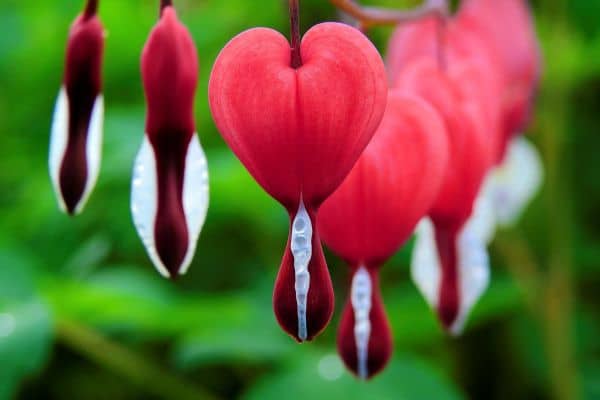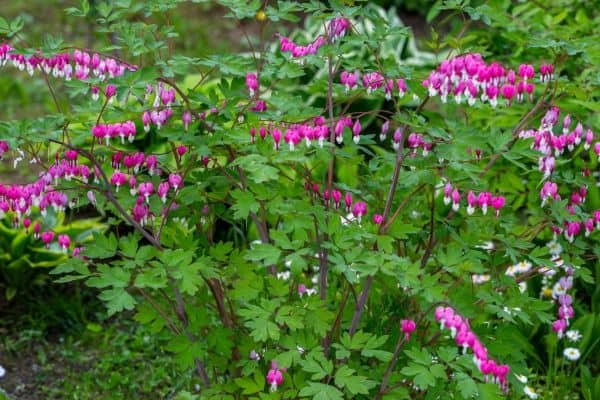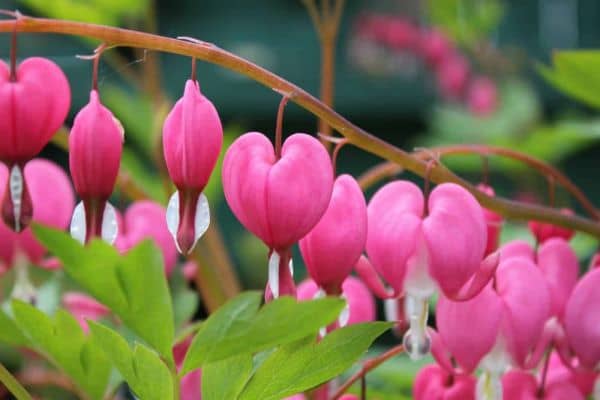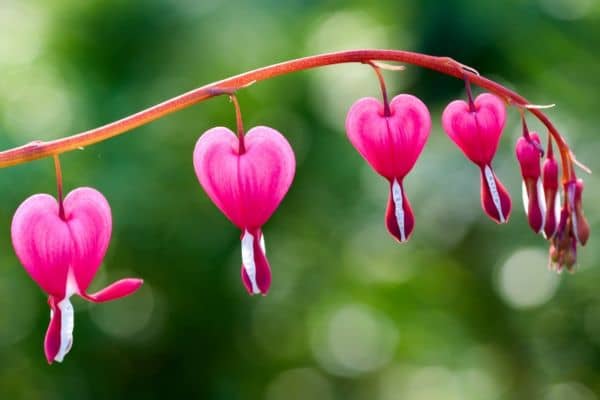The bleeding heart flower plant is a heart-shaped pink flowered plant that got its name from its puffy look. They have a white petal that looks like a drop beneath their heart-shaped flower and that’s how they got their name bleeding heart.
Bleeding Heart’s scientific name is Dicentra spectabilis and that symbolises sorrow and lost love. Today we will be learning how to grow and care for the bleeding heart flower:
How to Grow Bleeding Heart?
The bleeding heart flower plant should be planted after the threat of frost has passed so the right time to plant will be in early spring. They need well-draining soil with full sun or partial shade. They can grow up to 1 to 3 feet tall and 1 to 2 feet wide so if you are planting other plants near bleeding hearts you can space them accordingly. Once you have selected the soil, spot, and spacing then you can begin planting through the following steps:
- First, you need to dig a hole slightly bigger than the plant’s container it came in.
- After you have dug the hole then you need to loosen the soil in the bottom of the hole.
- Then gently remove the bleeding heart plant from the container.
- Just plant the bleeding heart at the same depth as it was in the pot.
- After all the step is done now all you have to do is water them deeply.

How to Care for Bleeding Heart?
The Bleeding Heart flower plant is known for being low-maintenance. So only routine care is needed for them to grow and as it is a low-maintenance plant many gardeners love to grow it. So here are some of the routine care for the Bleeding Heart flower plant:
1. Sun
If the Bleeding Heart flower plant is planted in high sun or in a dry place it will fade away. You need to plant them in full sun or part shade for the best results from the plant. They mostly need full sun if they are in moist places or in cool climates.
2. Soil
Bleeding Heart flower plants mostly need well-draining, moist, and humus-rich soil to grow them properly. They mostly prefer slightly acidic soil with a pH range of 6 to 6.5.
3. Water
If the Bleeding Heart flower plants are planted new they require frequent water of up to 1 inch per week to establish themself. You will also need to water deeply and it is also preferred to water a little every day. Also if the flowers have started to wilt then also you will have to water them.
4. Temperature
Even if the temperature is not good the Bleeding Heart flower plants will grow slowly and not bloom any flowers. They mostly are adaptable to a wide range of climates but they mostly need temperatures from 55 to 75 degrees. If the temperature is high for the Bleeding Heart flower plants then you can just need to ramp up your watering schedule.
5. Fertilizer
If your garden or container has moist and humus-rich soil then the Bleeding Heart flower plants will not be required any fertilizer. But if the soil quality is poor then you can use an all-purpose organic fertilizer once a year in spring to grow and bloom them properly.

Types of Bleeding Heart
There are a lot of varieties available for the Bleeding Heart flower plants. But all of the varieties three of the Bleeding Heart flower plants are common among gardeners and they are as follows:
- Lamprocapnos spectabilis: Lamprocapnos spectabilis is one of the common bleeding heart flower plants. They have lacy green leaves and produce pink and white colored flowers during their blooming season that look like hearts. Spectabillis the name of the varieties means spectacular or showy.
- Lamprocapnos spectabilis ‘Alba’: Lamprocapnos spectabilis ‘Alba’ is the same as the Lamprocapnos spectabilis but Lamprocapnos spectabilis ‘Alba’ doesn’t have a mix of pink and white colored flowers but it only has a white colored flower. It is also slightly less vigorous and tolerates summer heat better.
- Lamprocapnos spectabilis ‘Gold Heart’: Lamprocapnos spectabilis ‘Gold Heart’ is another gardener’s favorite and common Bleeding Heart flower plant that has only pink colored flowers with foliage in bright gold with green undertones.

Common Problems With Bleeding Heart
Every plant has common problems and the Bleeding Heart flower plants also have some common problems and they are as follows:
- Powdery Patches on Foliage: The Bleeding heart plant can get spots of black, gray, white, or pink powder on bleeding heart leaves which means a treatable disease when caught by the plant. To stop that from happening you need to water on soil rather than on foliage.
- Brown or Black Spots on the Leaves: If your bleeding heart has developed small brown or black spots on its leaves which later turn into a large and yellow halo in the center and later rots. You can stop that from happening with the use of fungicide or baking soda solution in the early stage.
- Yellowing Leaves: If A bleeding heart plants turn yellow then they have two possibilities one happens naturally if the temperature is high and dies but grows back again as is a normal cycle of growth. The second is if you water the bleeding heart plants too much water, if the soil is alkaline, or if the plant is getting too much sun if this condition happens then you can stop that from happening by adjusting the plant’s necessary conditions.
- Browning, Blackening, or Rapid Wilting of the Plant: If your bleeding heart flower plants happen to brown, blacken, or rapidly wilt you can stop that from happening through different methods and it may be the cause of verticillium wilt, fusarium wilt, botrytis, and root rot. If the browning starts to occur that means the plant is beginning to rot most of the time it may be the cause of fungal issues. You can use a fungicide if that happens.
FAQs
Q. When to Plant Bleeding Hearts?
The bleeding heart flower plant should be planted after the threat of frost has passed so the right time to plant will be in early spring.
Q. Are Bleeding Searts Plant Toxic?
Yes, the Bleeding Heart plant is toxic as it contains isoquinoline alkaloids which are harmful to both humans and animals. Bleeding Heart poisoning is less common in humans but they are common in dogs and horses. If the Bleeding Heart plant is taken in large quantities it can also cause liver damage and seizures in humans.
Q. Can You Grow Bleeding Hearts Indoors?
Yes, the Bleeding Heart flower plant can be grown indoors if you create ideal growing conditions indoors. But if they get cold drafts and heating vents indoors with high-temperature they may not bloom any flowers.
Also Read: What’s a Craftsman Style House? Know About Their Style, History And Features!
